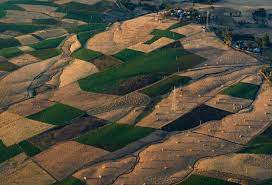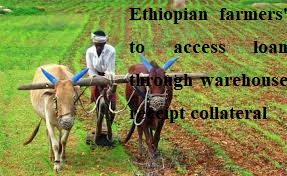
BY LAKACHEW ATINAFU
As an agrarian nation and many are employed and depend upon it, time demands to transform the agriculture sector and thereby achieve self-sufficiency in Ethiopia, which has potentials in crop production and animal husbandry.
Many argue that if Ethiopia able to utilize its resources and cultivates arable lands, it can feed itself and the neighboring countries due to the availability of blessing of varied climate and abundant resources.
The primary economic activity in Ethiopia practiced for many centuries however, the sector yet crawling and the remains subsistence. Thus, rather than babbling and inculcating problems, all should move hand in hand to avert the hand to mouth living condition, get rid of foreign aid and imported food products.
Unlike any other geographic entities on the planet, Ethiopia possessed diverse climatic zones which are suitable for farming and herding. Between the spatial variations ranging from thousands of meters and to some hundred meters above and below sea levels respectively, the land bears several types of plants and animals respective of the altitudinal difference.
Living the agronomy the science of growing crops and managing soil aside for the time being, empirics tells that, such altitude diversity is latent for production of numerous crops. Presently, due to the concern given to the sector, the country has been registering glittering success in production and productivity that the attribute concerted to commitment and dedication leadership, adoption of updated technologies, finding of researches out puts and utilizing them among others.
As time gone by, there has been improvement and bright hope if the country is able to exploit resources appropriately and can be the hub of production than to be a mere self-sufficient. The Ministry of Agriculture (MoE) manages to achieve the countries stretched goal in the sector formulating policies and strategies from consumption products to commodities that can generate foreign currencies.
Amid this, setting plans deploying experts and stakeholders should be taken as the cardinal principle to reach the scoreboard. The former achievements in the sector revealed that how the policies are sound though no one denies that there were shortcomings yet.
According to Fekadu Bireda, Head of the Crops Desk at the Ministry of Agriculture who had moment of togetherness with the Ethiopian Press Agency; in the 2015/16 maher season, more than 508 million quintals are expected to be produced from 8 million hectares of land covered by cluster and regular agriculture at the federal level.
According to Fekadu; the necessary preparations are being made for this year’s maher season. Fekadu said that the work of clustering is being implemented on 12 selected crops at national level.
He also stated that the agriculture work of the crop production will focus on the cultivation of wheat, barley, teff, corn, sorghum and other crops. Fekadu said that the works to be done in the practical and preparatory phases have been detailed and put to work. He said that during the maher season, 8.5 million hectares of land will be cultivated in cluster farming.
Fikadu further said that it is planned to earn more than 299 million quintals of yield from the land cultivated in clusters at a national level. The head said that the production grown in the cluster is growing from time to time. He also said that works are being done to increase cluster development from last year’s 6.2 million hectares to 8.5 million hectares.
He also stated that efforts will be made to mobilize the necessary resources at hand, provide support and monitoring, provide skill training, mechanization services and create market linkages to the farmers. He also unveiled that his office readiness to deploy the necessary mechanisms at the federal and regional stats level to expand the land cultivated in clusters, irrigation for the desired purpose.
He recalled that in the last maher season, 13.9 million hectares of land was covered with seeds and 394 million quintals were harvested. Experts globe wide believe that agriculture is the backbone of Ethiopia’s economy, but its development faces several bottlenecks. One of the main concerns is the low financial capacity of both smallholder farmers and small and medium-size enterprises (SMEs) and the limited access to credit in order to purchase goods and pay for services (input and technical training providers), and to process and sell their production (processing, marketing and link with exporting companies).
This is due both to the limited capacities of the agricultural SMEs to develop a credible business model or present solid financial information and the poor knowledge of the sector among public and private banks in Ethiopia and their weak capacity to develop adapted financial tools. Large agricultural companies or exporting companies are the core target of commercial banks, while smallholder farmers can have access to microfinance institutions’ offers. The SMEs’ financing needs find few appropriate responses among financial institutions.
To avert the situation the current government which assumed power some five years back has undergone several reforms paying due attention for urban agriculture, planting seedlings, exporting edible fruits and mechanizing the agriculture especially introducing the practice of dry wheat production.
In doing so with the ambition to export wheat the government has been making smart move convincing small holders to be organized in cluster. Most of the wheat in Ethiopia is grown by smallholder farmers. With increased mechanization, yields have doubled over the last 15 years according to government data. However, productivity remains low and output still falls short of demand.
Traditionally, Ethiopia has been growing wheat in the highlands and depending on rain. It is now supplementing that by growing wheat in the lowlands, which are often drier, through irrigation.
The government is also encouraging “cluster farming”, mechanization and subsidizing and distributing inputs such as fertilizer and high-quality improved seeds. Through this, Ethiopia is pushing to fully stop importing wheat. It is a very realistic and achievable goal, since the nation has irrigable 500,000 hectares of land which is not currently cultivated according to authorities.
Thus, it is recommended that advancing Business development skills and strengthening agri-SMEs through Agrihub, a platform is essential. In addition, comprising of three tiers of business development services to SMEs adapted to their scale, maturity and needs (Center of Excellence, Capacity Booster, and Accelerator) is vital.
All should support agri-SMEs to obtain loan from banks so that, they will build their capacity strengthening of financial muscle and adapt incentive mechanisms including credit guarantees, and create link with financial institutions.
It is also an integral working for the development of a sustainable economic model for Agrihub to ensure the sustainability of large scale production and further outreach post project, through the documentation of efficient methodologies and tools and the strengthening of a network of partners and service providers
Wheat production boom
The Ethiopian Herald June 4/2023





